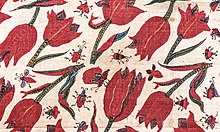Chintz
Chintz ( The cloth is printed with designs featuring flowers and other patterns in different colours, typically on a light, plain background.
Name
The name is derived from the
Unglazed calico was traditionally called "cretonne". The word calico is derived from the name of the Indian city Calicut (Kozhikkode in native Malayalam), to which it had a manufacturing association. In contemporary language, the words "chintz" and "chintzy" can be used to refer to clothing or furnishings which are vulgar or florid in appearance, and commonly in informal speech, to refer to cheap, low quality, or gaudy things, and similarly, to personal behavior.
The term 'chintzy' is also attributed to novelist George Eliot, who in 1851 wrote about muslin fabric to her sister, saying: "The quality of the spotted one is best, but the effect is chintzy." This is believed to have been said about cheap British imitations of real chintz, which became common at the time.[6]
History


Chintz was originally a
With imported chintz becoming so popular with Europeans during the late 17th century, French and English mills grew concerned, as they did not know how to make chintz. In 1686 France declared a ban on all chintz imports. In 1720 the Parliament of Great Britain enacted a law that forbade "the Use and Warings in Apparel of imported chintz, and also its use or Wear in or about any Bed, Chair, Cushion or other Household furniture".
Spain followed England and France to ban calico imports. Firstly in 1717 Asian textiles were banned. Then in 1728 the import of European made imitations of Asian textiles was banned in Spain. Additionally the second edict had as one of its objectives to encourage a local, import-substituting weaving and printing industry in imitation of England.
Even though chintz was outlawed, there were loopholes in the legislation. The Court of
In 1742, another Frenchman, Father Coeurdoux, also supplied details of the chintz making process, while he was trying to convert the Indians to
Europeans at first produced reproductions of Indian designs, and later added original patterns. A well-known make was toile de Jouy, which was manufactured in Jouy-en-Josas, France, between 1700 and 1843. Eventually the word in English came to describe any industrially printed cotton.[6] Modern chintz usually consists of bright overall floral patterns printed on a light background, but there are some popular patterns on black backgrounds as well.
Books
Cloth that Changed the World is a book about chintz by Sarah Fee that explains the story of Indian chintz.[8][9]
Gallery
-
Chintz from the Coromandel Coast, India, c. 1710–1725. Victoria and Albert Museum.
-
Chintz jacket, 1750–1800.MoMu, Antwerp.
-
Woman's robe à l'anglaise in chintz, c. 1770–1790. MoMu, Antwerp
-
18th-century chintz dresses.
-
Wooden block for printing chintz, 18 century. Museum of the History of Barcelona.
-
Barcelona chintz shop, c. 1824. Painting attributed to Gabriel Planella i Conxello. Museum of the History of Barcelona.
See also
References
- ^ "chintz". Oxford English Dictionary (Online ed.). Oxford University Press. (Subscription or participating institution membership required.)
- ^ JSTOR 44148394.
- ISBN 9780429724633. Retrieved 23 June 2020.
- OCLC 30111536.
- ^ Chisholm, Hugh, ed. (1911). . Encyclopædia Britannica. Vol. 6 (11th ed.). Cambridge University Press. p. 235.
- ^ a b c d Bekhrad, Joobin (2020-04-21). "The floral fabric that was banned". BBC. Retrieved 2020-04-22.
- ^ "Saturday 5 September 1663". The Diary of Samuel Pepys. Retrieved 14 December 2018.
- ^ Bekhrad, Joobin. "The floral fabric that was banned". www.bbc.com. Retrieved 2021-06-30.
- ^ "Cloth that Changed the World by Sarah Fee". Yale Books UK. Retrieved 2021-06-30.
External links
- An exhibition of calico and chintz at the Smithsonian American Art Museum
- Chintz Applique Quilts: From Imitation to Icon – Online exhibition at the International Quilt Museum, University of Nebraska–Lincoln
- On Chintz. An interview with chintz expert Rosemary Crill, senior curator at the Victoria and Albert Museum.






